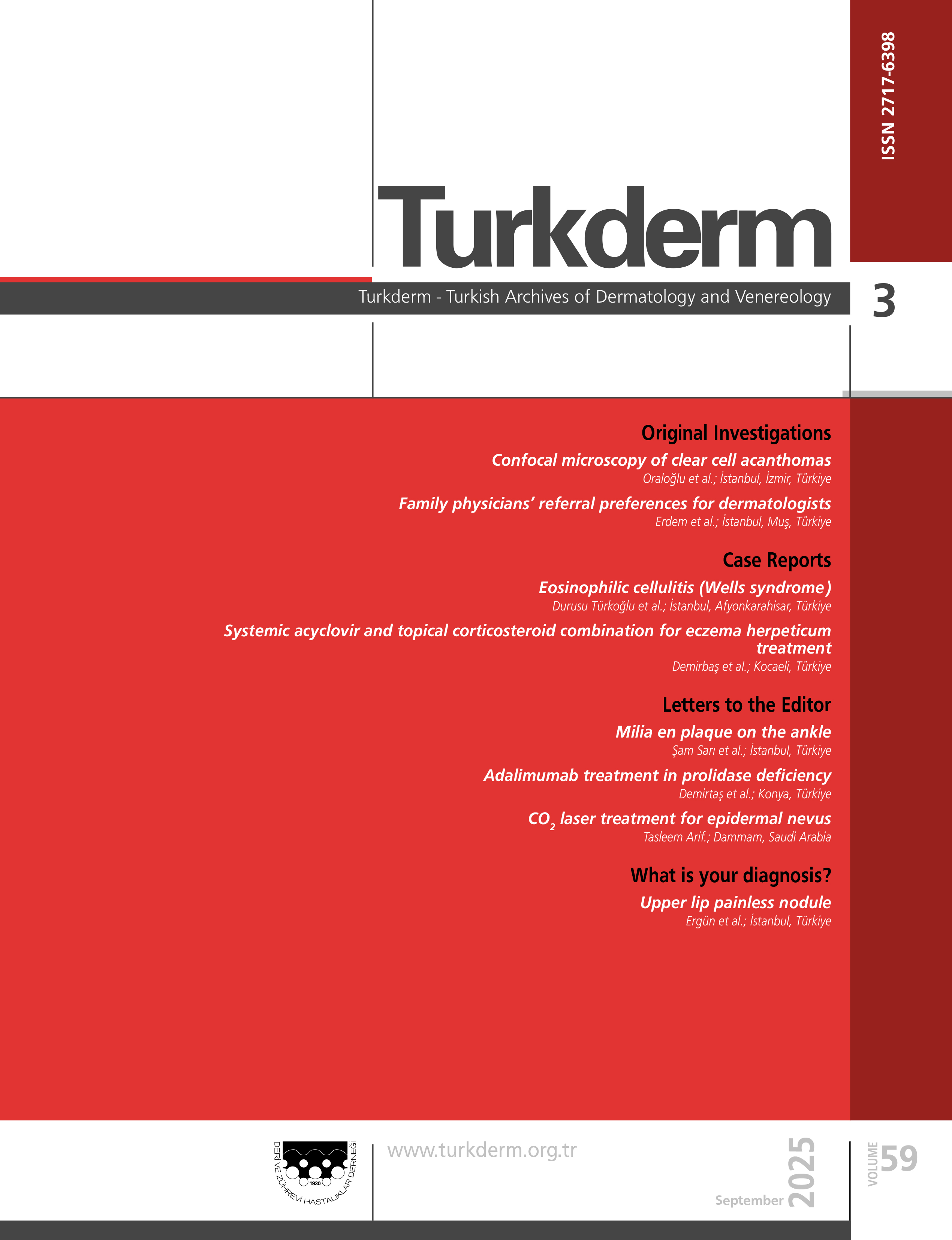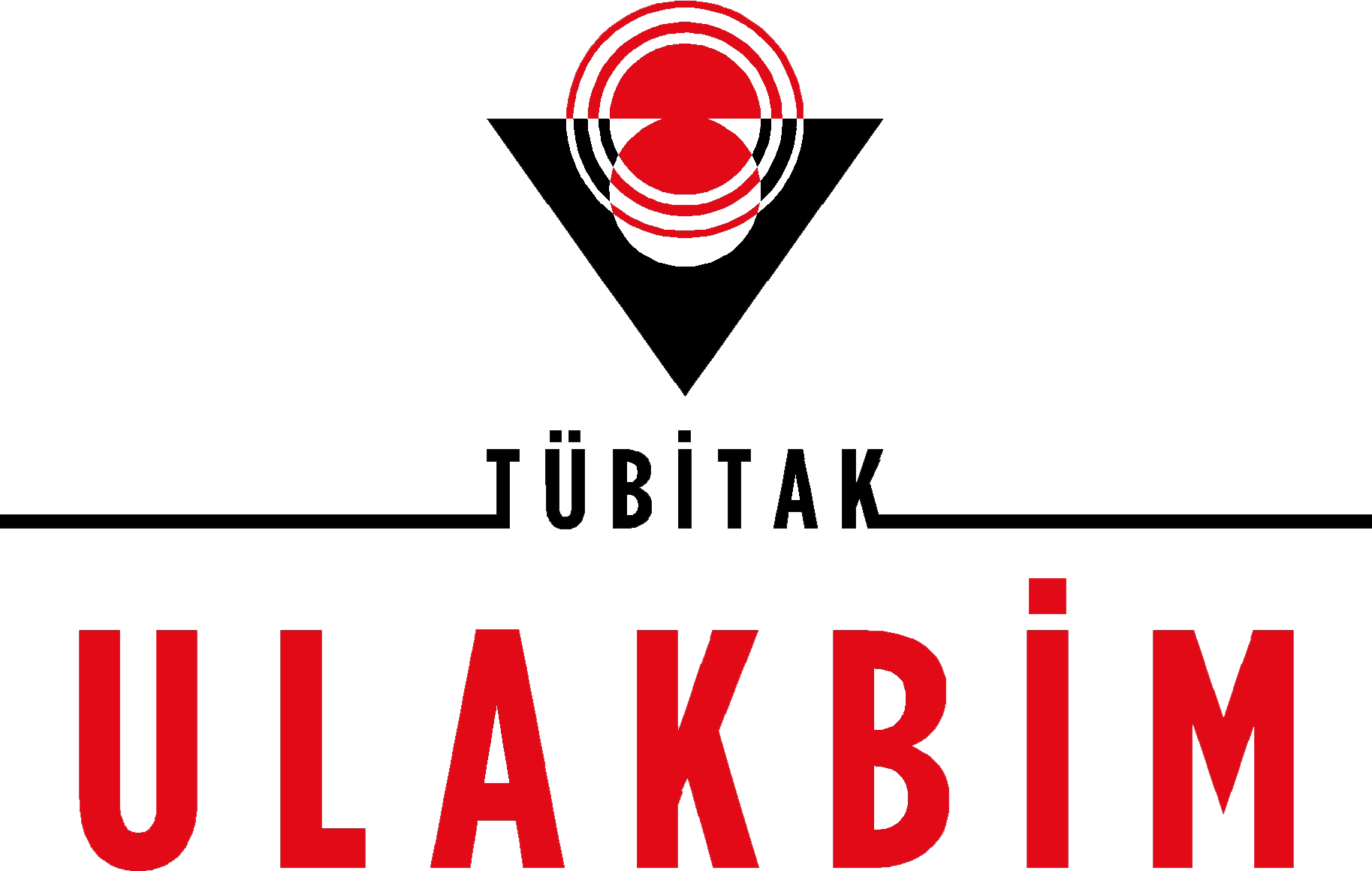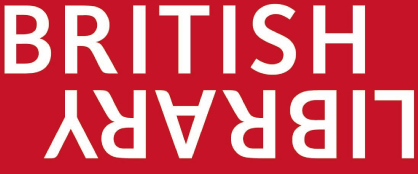Correlation of clinical, dermoscopic, and histopathological features of basal cell carcinoma
Didem Dizman1, Dilek Bıyık Özkaya2, Anıl Gülsel Bahali3, Buğçe Topukçu Dizman4, Pelin Yıldız5, Zeynep Tosuner6, Cüyan Demirkesen5, Nahide Onsun7, Özlem Su11Bezmialem Vakıf University Faculty of Medicine, Department of Dermatology and Venereology, İstanbul, Türkiye2Acıbadem University Faculty of Medicine, Department of Dermatology and Venereology, İstanbul, Türkiye
3Liv Hospital, Clinic of Dermatology and Venereology, İstanbul, Türkiye
4Medistate Hospital, Clinic of Dermatology and Venereology, İstanbul, Türkiye
5Acıbadem University Faculty of Medicine, Department of Pathology, İstanbul, Türkiye
6University of Health Sciences Türkiye, Başakşehir Çam and Sakura City Hospital, Clinic of Pathology, İstanbul, Türkiye
7Biruni University, Medical Faculty, Dermatology and Venereology Department, Istanbul, Turkey
Background and Design: The aim of this study is to enhance the diagnosis and treatment of basal cell carcinoma (BCC) by comparing clinical, dermoscopic, and pathological features.
Materials and Methods: This retrospective study included patients from the dermatology clinic between 2012 and 2015 with 111 BCC lesions.
Results: The average age for aggressive-type BCC patients was higher. Aggressive-type BCCs were more common on the face. Dermoscopic, gray-blue ovoid nests were more common on the trunk. Pigmented dots were less common on the face, while globules were more frequent on the scalp. Small erosions were more prevalent on the extremities, while shiny white-red structureless areas were more common on the trunk and extremities. Dot vessels were more prevalent on the scalp. Vascular features were more common on the face, whereas pigmented characteristics were less common. Other dermoscopic features were more common on the face and trunk. Arborizing vessels, ulcerations, white crystals, and hairpin vessels were more common in nodular lesions. Other dermoscopic features were more prevalent in nodular lesions. Mixed-type BCCs had more gray-blue ovoid nests and globules, while single-type BCCs had more small erosions. Vascular features were more common in mixed-type BCCs. Ulceration was more common in aggressive BCCs, while small erosions were more prevalent in nonaggressive BCCs. Histopathologically, pigmented BCCs were more common on the scalp and trunk than on the face. Superficial BCCs were more common in trunks and flat lesions. Adenoid BCC was more prevalent in nodular lesions. Scalp mixed-type BCCs were more common and aggressive. Mixed-type BCCs had a higher number of subtypes, including pigmented, infiltrative, adenoid, micronodular, and solid BCCs. Cystic degeneration was more common in mixed-type BCCs.
Conclusion: Clinical-pathological correlations and dermoscopic findings improve our understanding of BCC, aiding in accurate diagnosis and management.
Bazal hücreli karsinomun klinik, dermoskopik ve histopatolojik özelliklerinin korelasyonu
Didem Dizman1, Dilek Bıyık Özkaya2, Anıl Gülsel Bahali3, Buğçe Topukçu Dizman4, Pelin Yıldız5, Zeynep Tosuner6, Cüyan Demirkesen5, Nahide Onsun7, Özlem Su11Bezmialem Vakıf Üniversitesi, Deri ve Zührevi Hastalıklar Ana Bilim Dalı, İstanbul2Acıbadem Üniversitesi, Deri ve Zührevi Hastalıklar Ana Bilim Dalı, İstanbul
3Liv Hastanesi, Deri Ve Zührevi Hastalıkları, Istanbul
4Medistate Hastanesi, Deri Ve Zührevi Hastalıkları, Istanbul
5Acıbadem Üniversitesi, Patoloji Ana Bilim Dalı, Istanbul
6Türkiye Sağlık Bilimleri Üniversitesi, Başakşehir Çam ve Sakura Şehir Hastanesi, Patoloji Kliniği, İstanbul, Türkiye
7Biruni Üniversitesi, Deri ve Zührevi Hastalıklar Ana Bilim Dalı, İstanbul
Amaç: Bu çalışmanın amacı, klinik, dermoskopik ve patolojik özellikleri karşılaştırarak bazal hücreli karsinomun (BCC) tanı ve tedavisini geliştirmektir.
Gereç ve Yöntem: Bu retrospektif çalışma, 2012 ve 2015 yılları arasında dermatoloji kliniğine başvuran ve 111 BCC lezyonuna sahip hastaları içermektedir.
Bulgular: Agresif tip BCC hastalarının ortalama yaşı daha yüksekti. Agresif tip BCCler yüzde daha yaygındı. Dermoskopik olarak, gri-mavi oval yuvalar gövdede daha yaygındı. Pigmente noktalar yüzde daha az yaygındı, globüller ise saçlı deride daha sık görülüyordu. Küçük erozyonlar ekstremitelerde daha yaygındı ve parlak beyaz-kırmızı yapısız alanlar gövde ve ekstremitelerde daha yaygındı. Nokta damarlar saçlı deride daha sık görülüyordu. Vasküler özellikler yüzde daha yaygındı ve pigmente özellikler yüzde daha az yaygındı. Diğer dermoskopik özellikler yüzde ve gövdede daha yaygındı. Nodüler lezyonlarda, arborize damarlar, ülserasyon, beyaz kristaller ve saç tokası damarları daha yaygındı. Diğer dermoskopik özellikler nodüler lezyonlarda daha yaygındı. Mikst tip BCClerde gri-mavi oval yuvalar ve globüller daha yaygındı, tek tip BCClerde ise küçük erozyonlar daha sık görülüyordu. Vasküler özellikler mikst tip BCClerde daha yaygındı. Ülserasyon agresif BCClerde daha yaygındı, küçük erozyonlar ise non-agresif BCClerde daha yaygındı. Histopatolojik olarak, pigmente BCCler saçlı deri ve gövdede yüzde daha yaygındı. Süperfisiyel BCC, gövdede ve düz lezyonlarda daha yaygındı. Adenoid BCC nodüler lezyonlarda daha sık görülüyordu. Mikst tip BCCler saçlı deride daha yaygındı ve daha agresif olma olasılığı yüksekti. Mikst tip BCCler, pigmente, infiltratif, adenoid, mikronodüler ve solid BCCler dahil olmak üzere daha yüksek alt tip görülme sıklığına sahipti. Kistik dejenerasyon, mikst tip BCClerde daha yaygındı.
Sonuç: Klinik-patolojik korelasyonlar ve dermoskopik bulgular, BCCnin anlaşılmasını geliştirerek doğru tanı ve yönetimi sağlar.
Manuscript Language: English























